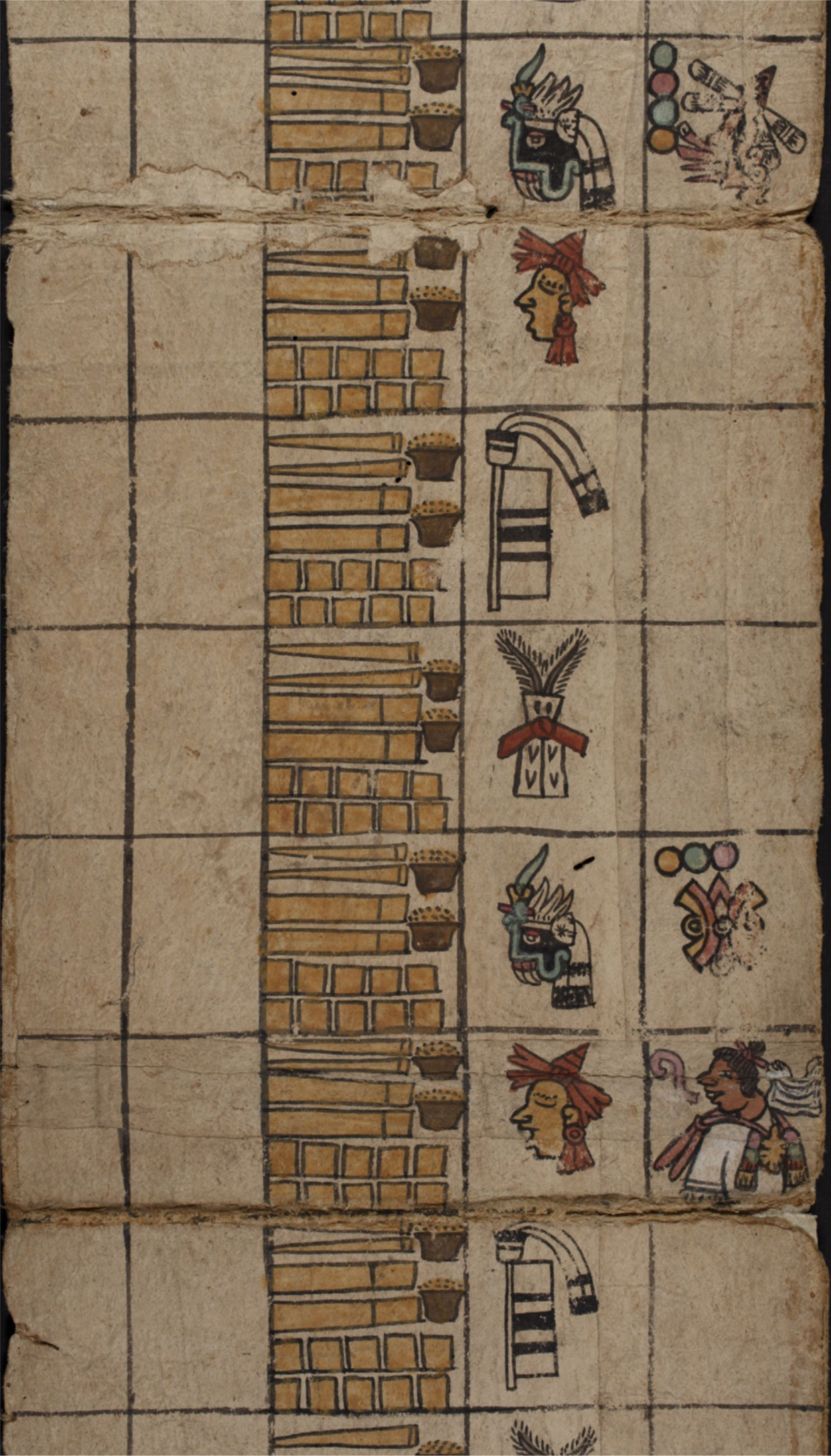A puzzle of fragments
Originally, almost all Humboldt fragments were parts of larger manuscripts, most of which belonged to screenfold codices. Many of them are now lost or spread over different countries. Some could be reconstructed across today’s national borders.
The following selection of fragments shows how the manuscripts puzzle was put together fragment by fragment:
Berlin meets Azoyú in Mexico
The tribute register from Aztec times
This screenfold is a register from Tlapa province with tributes to the Aztecs. It is already of impressive length on its own. But at least one has to double it if the Codex Azoyú 2 verso is added. This Codex was discovered in 1940 in Mexico, in the town of the same name. It constitutes the beginning of the tribute register.
Unfortunately, Codex Azoyú 2 is not complete either, but was cut into several parts in the 18th century. The remaining part of the codex begins with the treaty between Tlapa and the Aztecs on the payment of tribute in 1487.
The Codex exhibits the typical screenfold format and should be read from the bottom up and right to left. To read the codex in the Aztec way, start directly at the bottom.
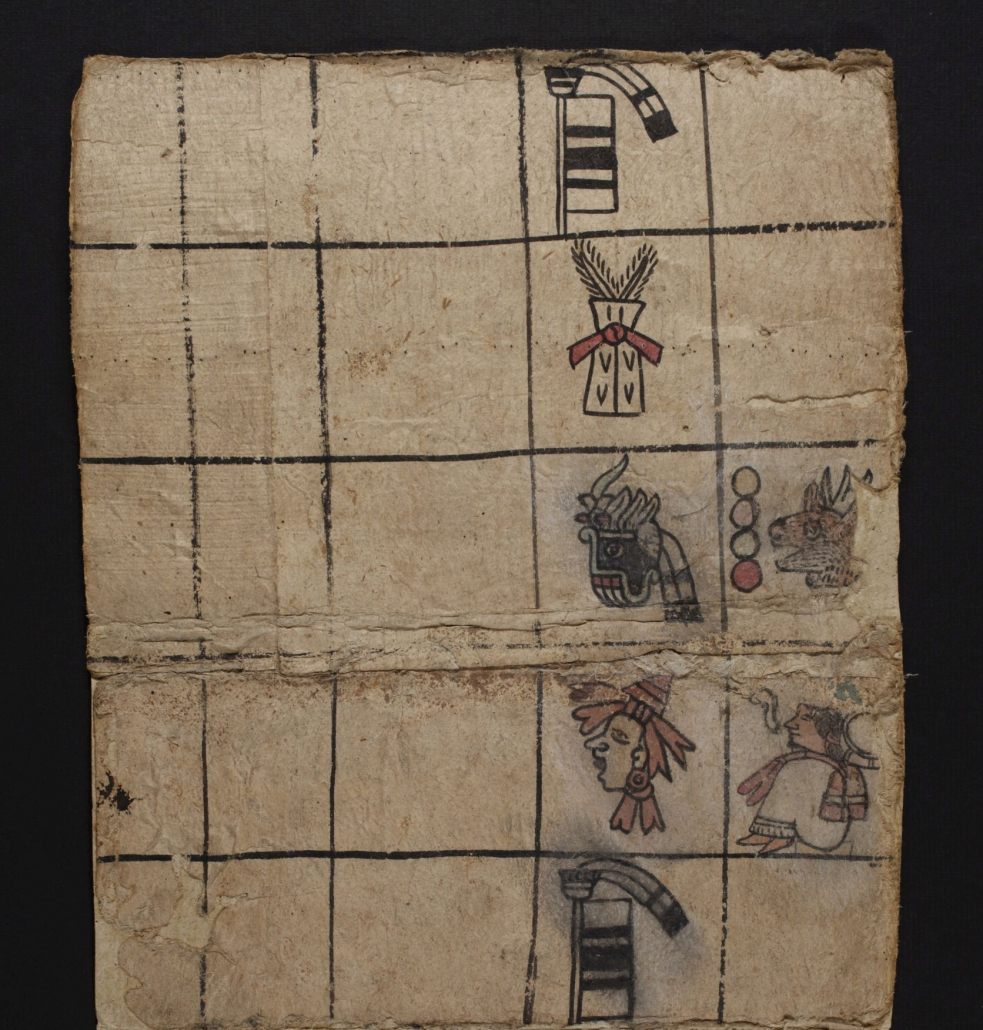
Due to the Spanish conquest of Tlapa, already in the month of Panquetzaliztli no tributes have been paid to the Aztecs.
No tributes are paid. By this time it was certainly known in distant Tlapa that the Aztecs had also been conquered.
It is the month of Tlacaxipehualiztli.
An Aztec administrator has arrived asking for tributes.
Year 4 Deer (= 1522)
The columns for the year count and the tribute months had been filled before the conquest. Tribute registration is not done any more.
Month of Panquetzaliztli
The last entry in the tribute register
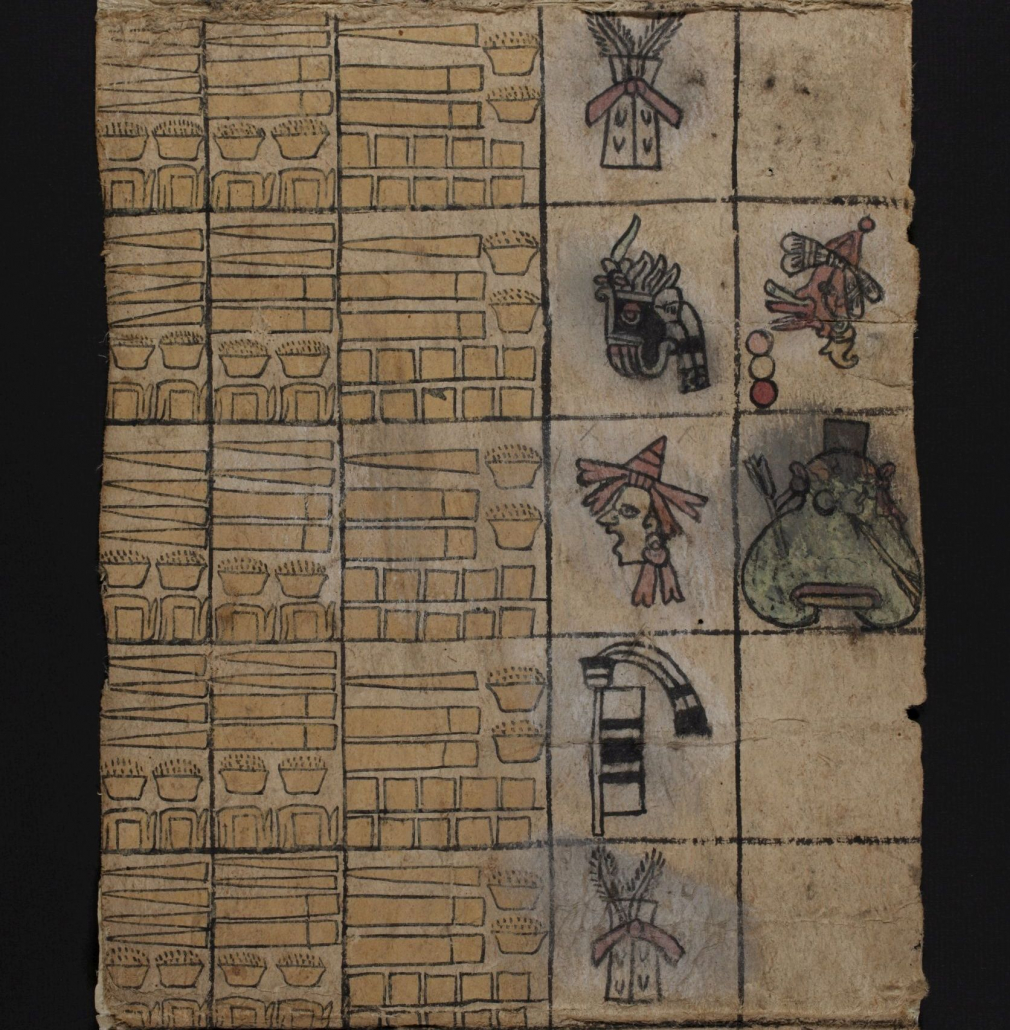
The Spanish conquest of Tlapa is indicated by arrows shot into the hieroglyph of its capital: a hill with the insignias of a ruler. It is explained in more detail on the wall to the left.
Year 3 Wind (= 1521)
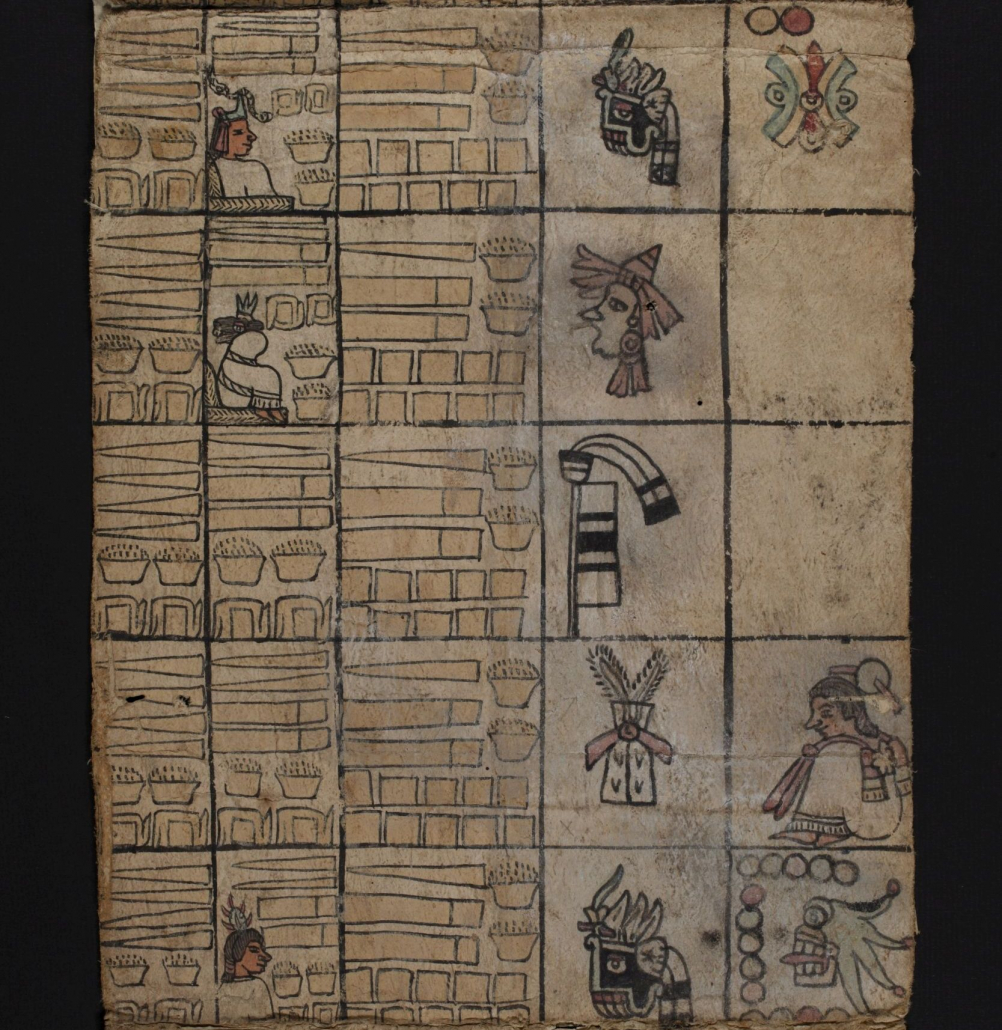
Year 14 Twisted Grass (= 1519)
After Tilma’s death an Aztec tribute collector oversees the payments. His name glyph is a prickly pear, so he might have been called Nochtli.
Another Aztec administrator has arrived in Tlapa. His name glyph is a jade disk, hence his name was probably Chalchuhuitl. He wears the same regalia like his predecessor: a stole with tassels of feathers and a golden butterfly.
Month of Ochpaniztli
It is the month of Ochpaniztli when Chalchuhuitl has arrived in Tlapa.
Year 2 Movement (= 1520)
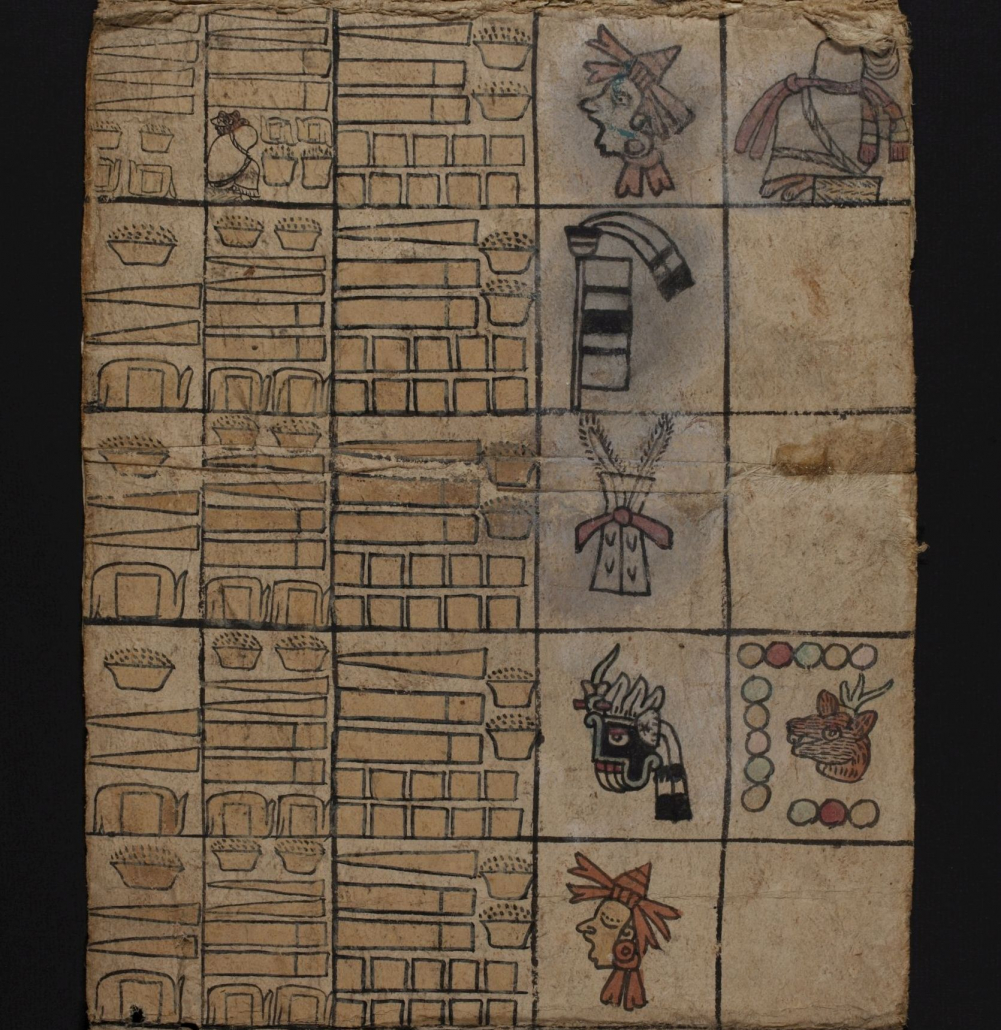
Year 13 Deer (= 1518)
The Aztec administrator Tilma has died. His funeral bundle is depicted with his stole and name glyph – a piece of cloth – on the back of his head.
Month of Tlacaxipehualiztli
It is the month of Tlacaxipehualiztli, when Tilma’s death is announced.
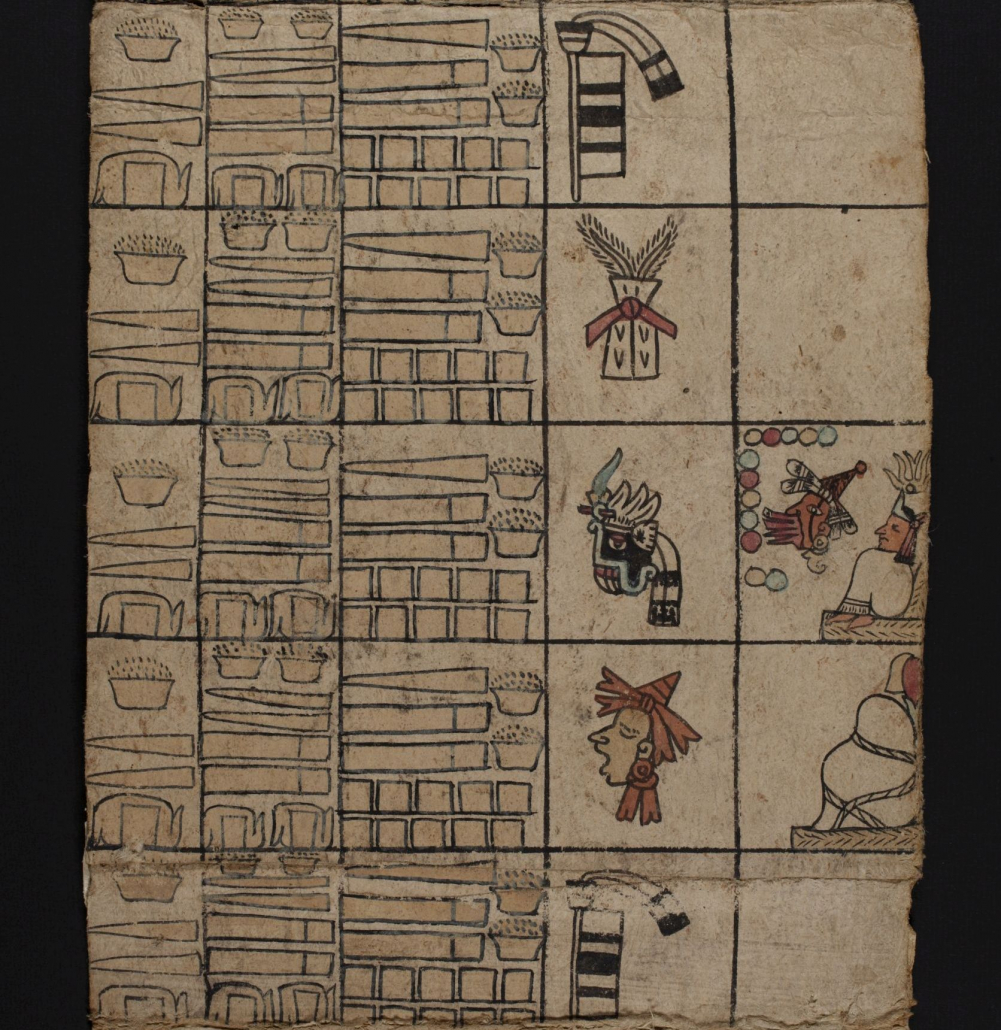
Tlapa’s ruler has died. His death is indicated by the white tied up funeral bundle and his name glyph, a xilote corn-cob.
Month of Tlacaxipehualiztli
It was the month of Tlacaxipehualiztli, when the tlapanec ruler’s death was announced.
Year 12 Wind (= 1517)
The next ruler of Tlapa ascends the throne. His name glyph is painted above his head: Flame.

Year 11 Movement (= 1516)
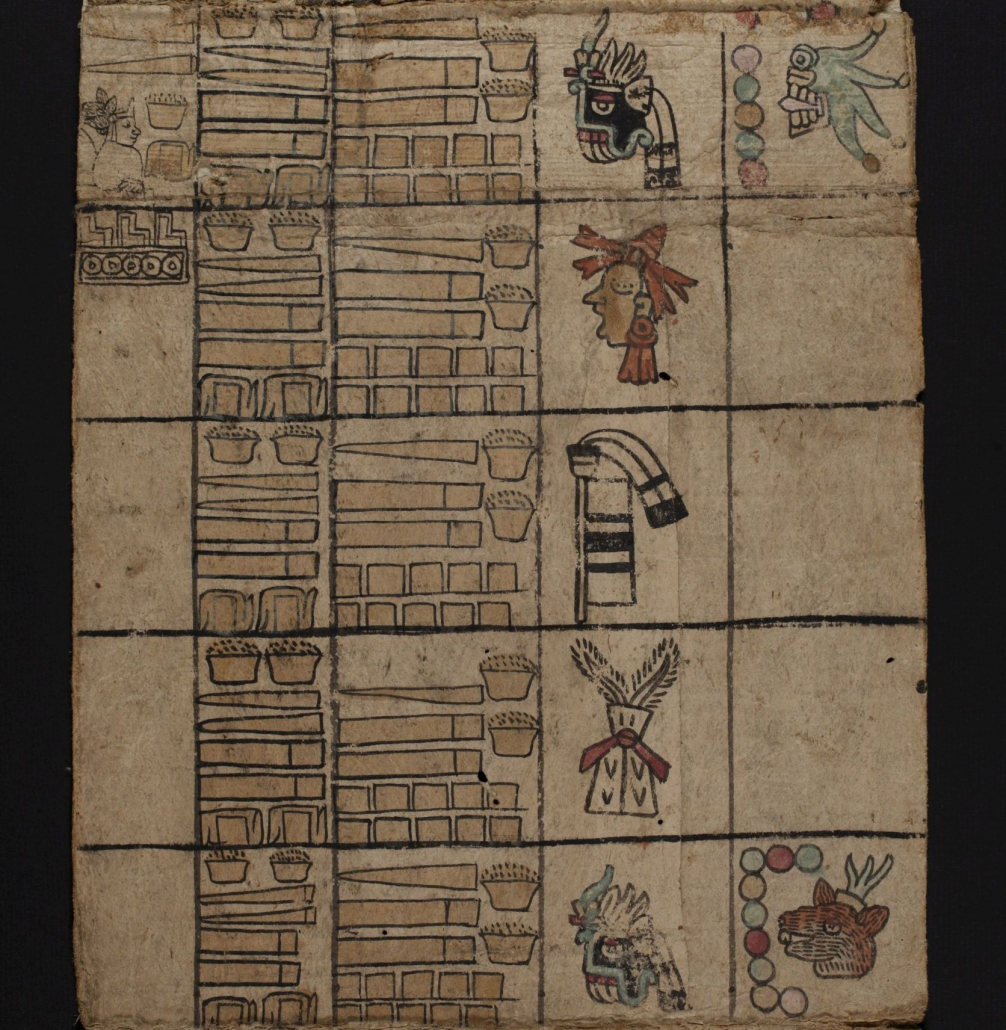
Year 9 Deer (= 1514)
Year 10 Twisted Grass (= 1515)
The tributes are increased again. In order to record them, even the space above the ruler’s glyph had to be used.
Another place is added to the tribute province of Tlapa.
The ruler´s name glyph is “dog”.
Tetenanco (Near the Stone wall)
The town is called Tetenanco. The place glyph is a crennelated wall.
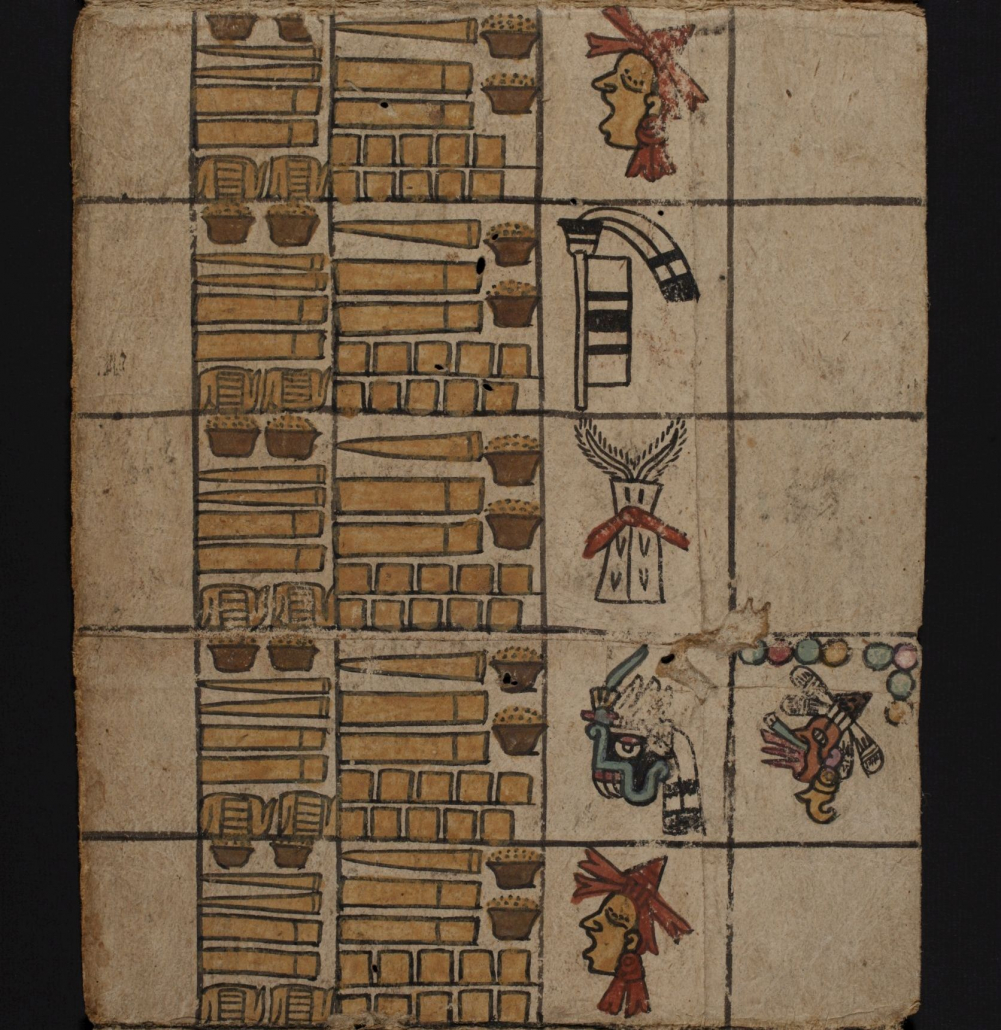
Jahr 8 Wind (= 1513)
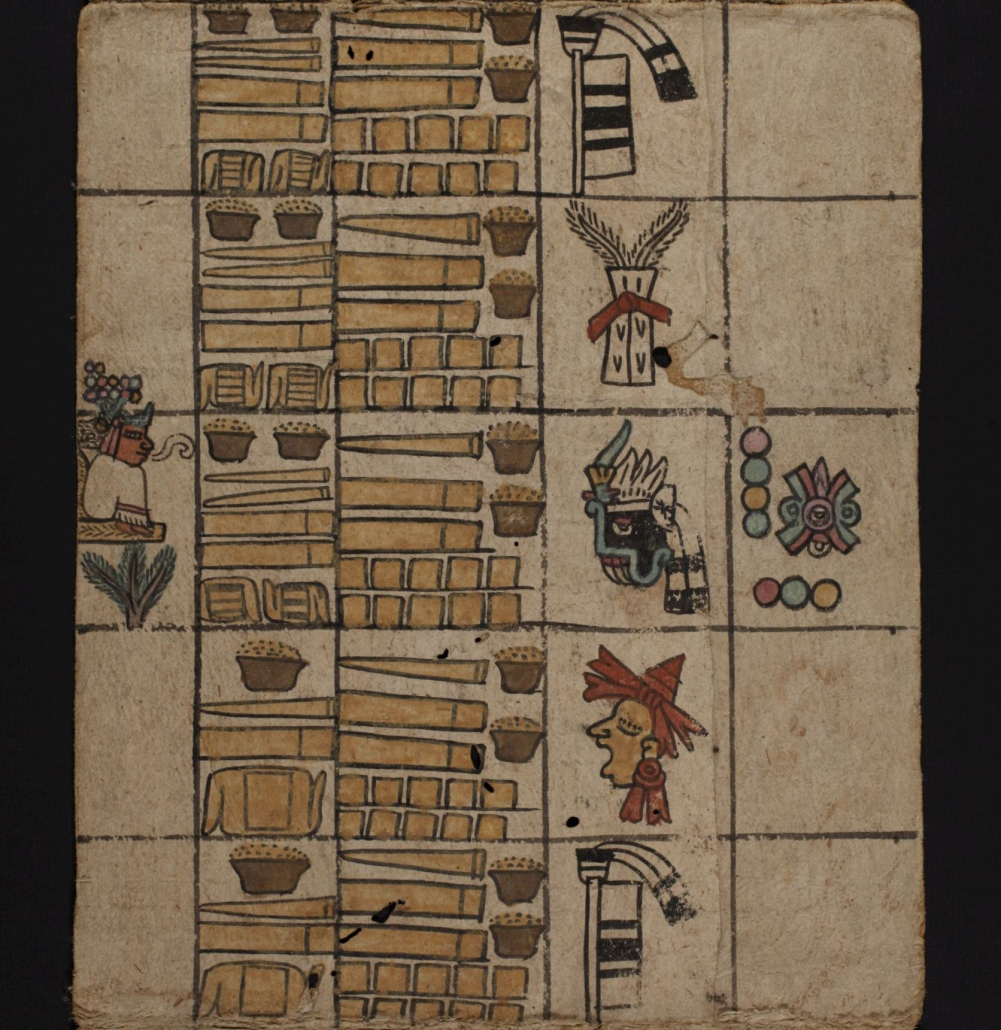
The ruler’s name glyph is a deer with the number 12, meaning that he was born on a day 12 Deer and that this day was also his name.
Once again an new tribute-paying town is integrated into the province of Tlapa.
In the year 7 Movement tributes are increased again:
3 triangular hammered gold leaves
4 rectangular hammered gold leaves
10 square hammered gold leaves
4 bowls of gold dust
2 bundles of stiped blankets
Year 7 Movement (= 1512)
The place glyph is a zacate-plant, a certain grass species after which the place was probably called (On the zacate-gras).

A new town that had to pay tribute is added, explainig the tribute increase of Tlapa.
The town’s ruler ist depicted with his turquoise diadem sitting on a reed throne with backrest, the volute coming from his mouth means that he orders the tribute payment. The name glyph on the back of his head is a jaguar.
Below the ruler´s seat there is the place hieroglyph: a hill with the blue-green water sign indicating Atepec, Waterhill.
From this month onward the register shows increased tributes. One additional field was needed to record them. The tribute amount is now:
2 triangular hammered gold leaves
3 rectangular hammered gold leaves
10 square hammered gold leaves
3 bowls of gold dust
1 bundle of stiped blankets
Month of Etzalcualiztli
It is the first month of the year 6 Twisted Grass.
Year 6 Twisted Grass (= 1511)

Year 4 Wind (= 1509)
Year 5 Deer (= 1510)
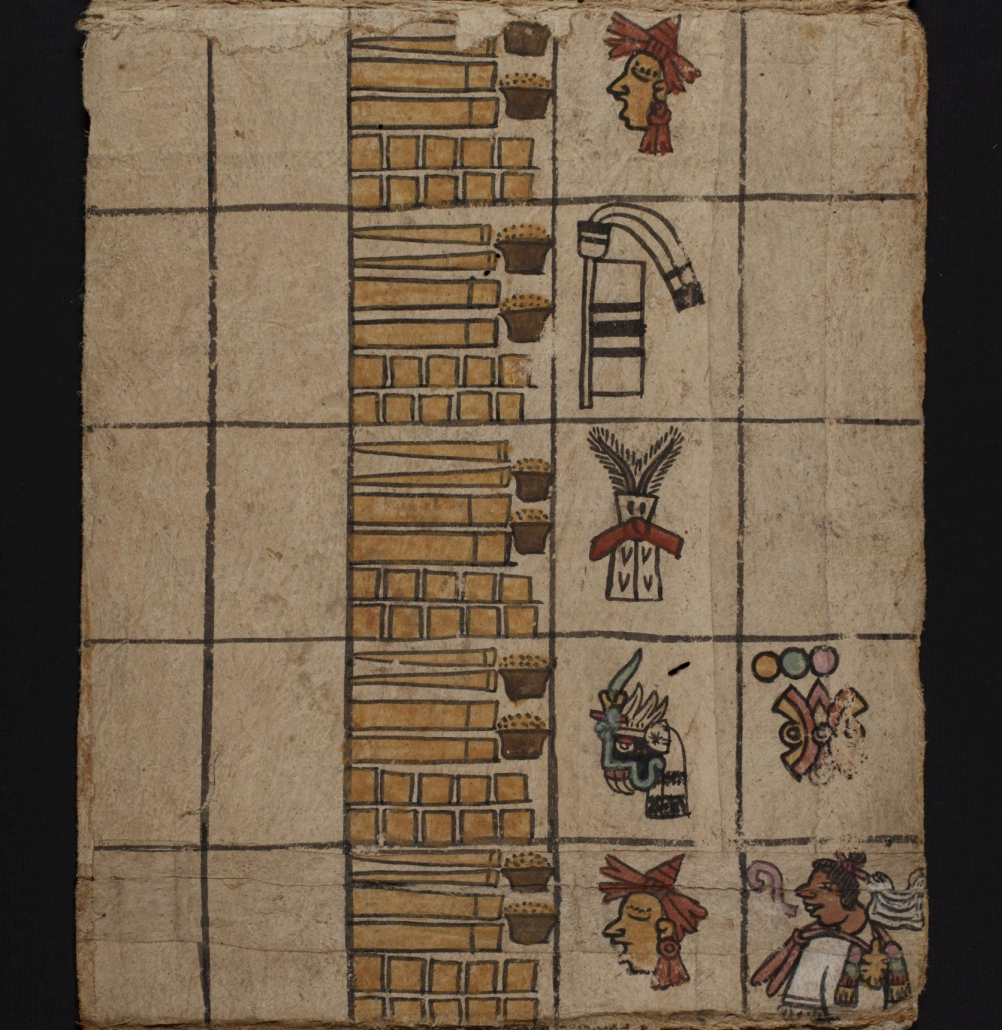
Month of Tlacaxipehualiztli
It is the fourth tribute month of the year 2 Twisted Grass. It was in this month, that the Aztec administrator Tilma arrived.
Arrival of the Aztec administrator Tilma
He is represented as a highly decorated military officer. Only those warriors who had taken four or more enemies on the battlefield were allowed to wear this hairdress. The administrator is demanding tribute payments. The glyph is shown in detail on the hieroglyphic wall to the left.
Year 3 Movement (= 1508)
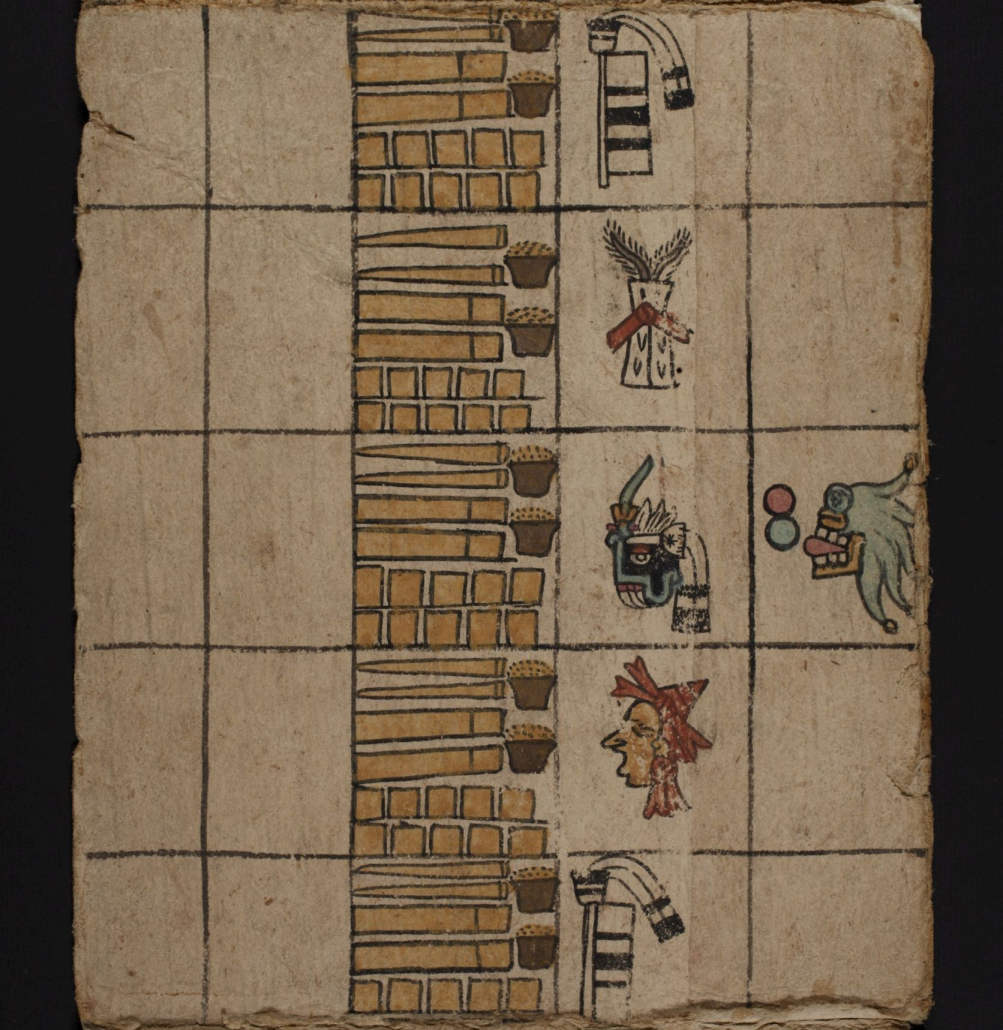
Month of Etzalcualiztli
Beginning of the year 2 Twisted Grass and a new tribute year as well
Year 2 Twisted Grass (= 1507)
In Tlapa the years were counted from 2 through 14. It differs from the Aztec calendar that ran from 1 through 13.
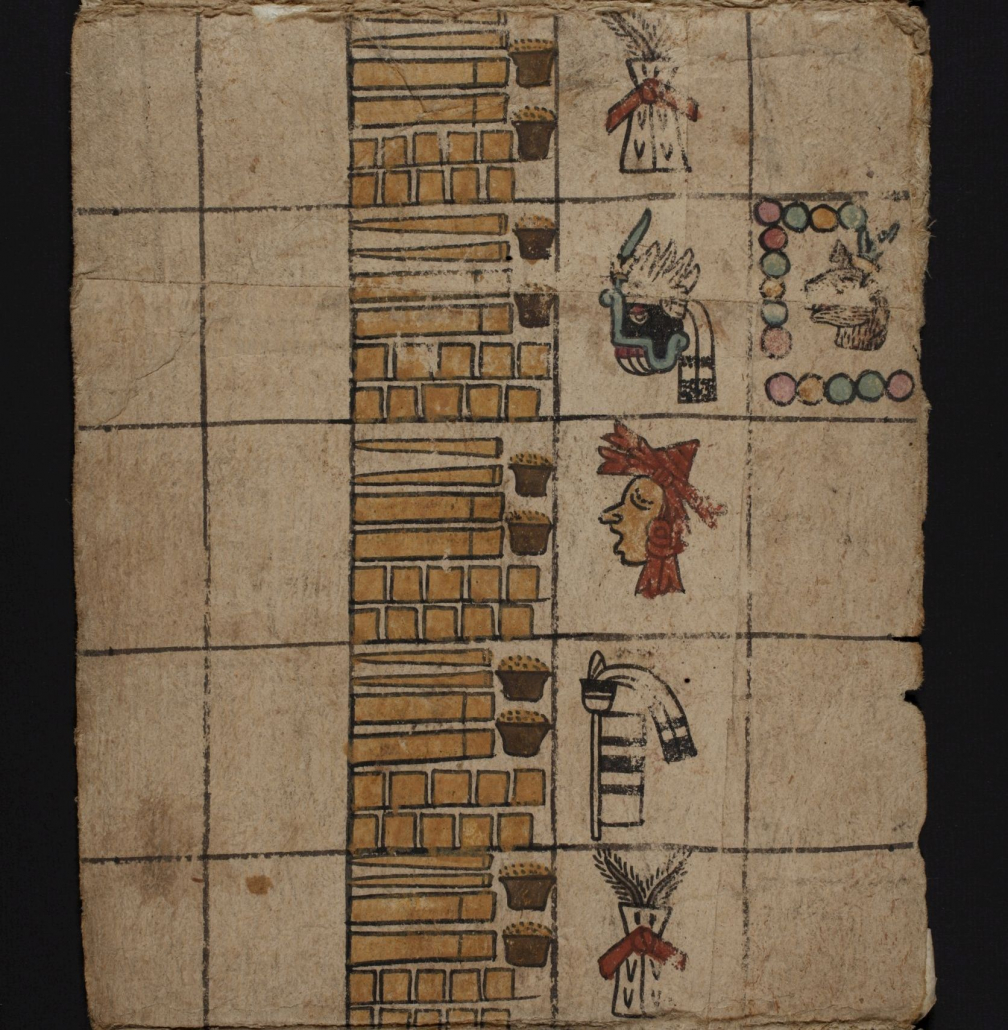
Month of Ochpaniztli
It is the second tribute month of the year 13 Wind.
Month of Panquetzaliztli
It is the third tribute month of the year 13 Wind.
Month of Tlacaxipehualiztli
It is the forth tribute month of the year 13 Wind.
Month of Etzalcualiztli
(when a meal of maize and beans was eaten)
It was the month, when the year 14 Deer began.
Year 14 Deer (= 1506)
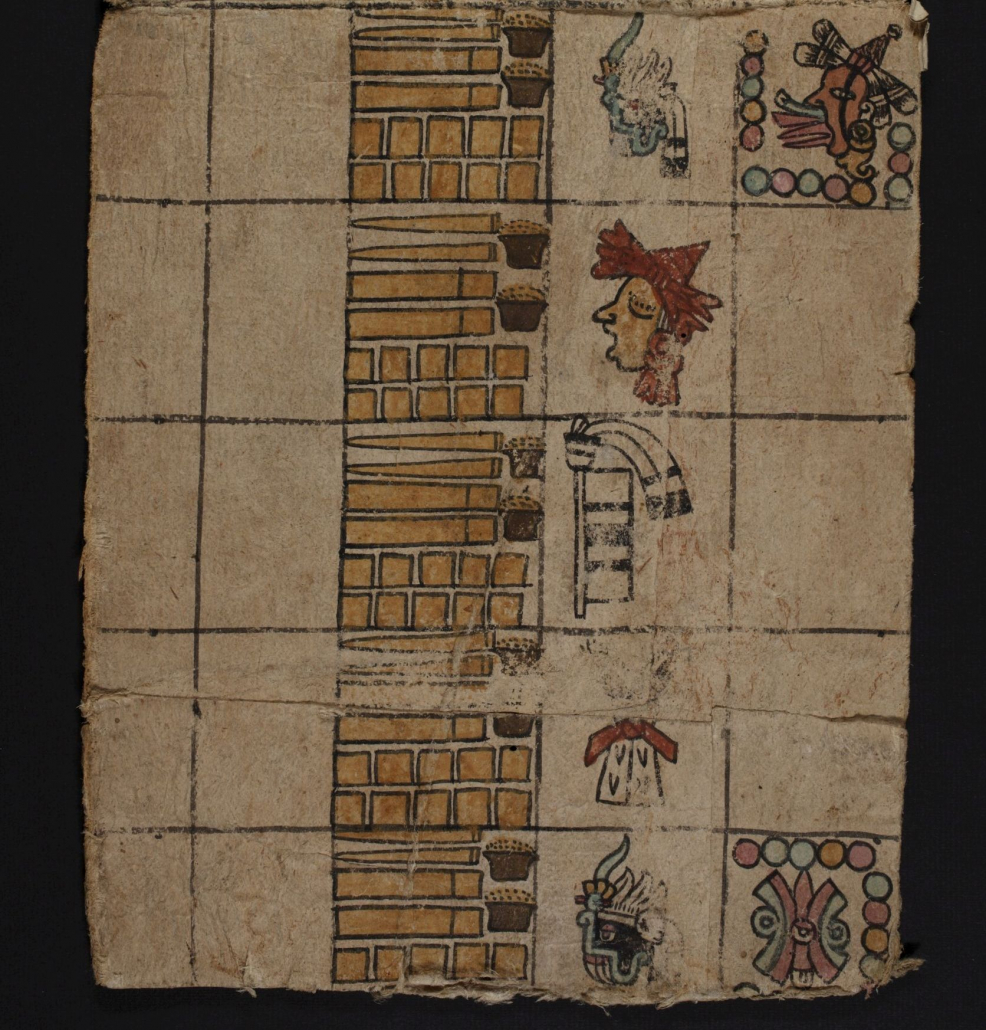
Year 12 Movement (= 1504)
Here is the beginning of the Berlin part of the tribute register
The number is painted one by one by adding small circles in alternating colours. It can re read only partially. The non-destroyd year-numbers above allow to reconstruct it.
Month of Etzalcualiztli
(when a meal of maize and beans was eaten)
It corresponds roughly to the month of June. In this month also fell the beginning of the solar year in Tlapa. It had 18 months with 20 days each and five additional days = 365 days.
Tlapan gave the following tributes this month:
2 triangular hammered gold leaves
2 rectangular hammered gold leaves (they represent the basic unit for gold leaves)
5 square gold leaves
2 bowls of gold dust
Month of Ochpaniztli
(month of sweeping the roads)
It is the second tribute month of the year 12 Movement. The line running across the sheet comes from adding a new sheet to the tribute register.
Month of Panquetzaliztli
(month of raising of the flags)
It is the third tribute month of the year.
Month of Tlacaxipehualiztli
(month of flaying of men)
It is the fourth tribute month of the year.
Year 13 Wind (= 1505)
Month of Etzalcualiztli
This month started the year 13 Wind.
Tribute register, Codex Humboldt Fragment I, Tlapa, Guerrero, México, ca. 1522. SBB-PK, Manuscripta americana 2, Humboldt Fragment I. © SBB-PK
Mexico meets Berlin
The cut-up bill of complaint
The four fragments must once have formed a single document with a central section that no longer exists: it is an approximately 2.5-metre-long bill of complaint from an unknown Indigenous community. At issue were unpaid bills and physical assaults by a Spaniard to pressure people into providing services. When the collector Lorenzo Boturini acquired this manuscript in the 18th century, it was still complete, as it is described in a court inventory of the collection taken after the authorities had confiscated it.
Humboldt only found two pieces of it, which he brought with him to Berlin, where they were later cut up again. The analysis of the pigments has confirmed their connection. We have reconstructed their sequence virtually.

60 jars of honey
200 bundles of red wood
Spaniard forces services
Carriers bring the wood to the place of the Spaniard
200 bundles of red wood
Yellow wood discs
Headboards and sideboards for bedsteads
Carriers with pulque jugs
Planks
25 baskets of pork
Three beams with a hole in the rounded end
21 laths
Two beams with a hole in the headboard
Carriers with vessels and measuring sticks
15 baskets of pork and 1 opuntia plant
10 baskets of pork
1 row with stones
23 laths
21 bevelled wooden panels
3 pigs
Here, the manuscript is missing a fragment.

Remains of wooden objects
12 red wood discs
6 red rectangular planks
20 narrow planks or laths
10 angle pieces or half-slices
Carpenter in front of 24 planks
6 frames
7 loads of stones
200 bundles of sticks, laths or firewood
15 angle pieces or half-slices
Carpenter in front of 3 beams
2 headboards and 4 sideboards for bedstead
10 cross-shaped frames, probably chairs
Wooden discs
6 planks
Carpenter with axe in front of his bill of 2000 cocoa beans
400 bundles of wood
Indigenous men being hung by their hands from gallows
The reconstructed manuscript of the Humboldt fragments in the sequence XI, XII, IX and X. SBB-PK, Manuscripta americana 1, Humboldt Fragmente IX-XII. © SBB-PK
Berlin meets Paris
The illegal taxes of Tlatempan
This Humboldt Fragment (see on the right) is small, just 14.6 x 34 cm. The counterpart in the French National Library, on the other hand (see below), measures an impressive length of 20 x 170 cm. Both show clear similarities: sections painted in yellow and red alternate. Tributes in money and goods are depicted almost identically. Differences are found in the positioning of the otherwise partially identical person hieroglyphs. Moreover, only the manuscript in Paris is dated section by section with Roman numbers. It also tells us what the manuscript is about: unlawful tributes extorted from the district of Tlatempan, presumably by its own Indigenous local administration.
In comparison with Humboldt Fragment XIV (see on the right), this section from the tribute register of Tlatengo shows stylistic similarities. Rôle des impôts de Tlatengo, 1592. Bibliothèque nationale de France. Département des Manuscrits. Mexicain 390. © Bibliothèque nationale de France
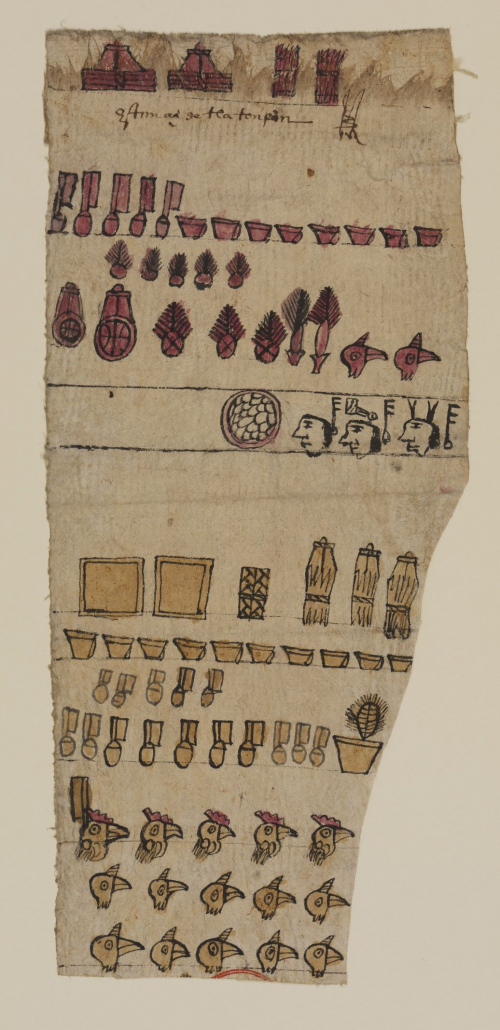
A load of wood
Estancia de Tlatempan (handwritten)
The hieroglyph Peso is a circle with eight segments standing for the eight Reales of the Peso. Above the circle there is a balance as coins were often weighed in order to determine whether they were genuine or not.
400 cocoa beans
Chillies
Year hieropglyph
It stand below each year with tax payments.
The three treasurers of the main village receiving the taxes of Tlatempan.
The huge keys behind their heads show that they possessed the keys to municipal coffer (caja de la comunidad).
Woven blankets
Bundle of reed mats
Bundle of hay
Measuring vessels with maize
20 calabash bowls
Chicken
Record of the tributes from the district of Tlatempan. SBB-PK, Manuscripta americana 1, Humboldt Fragment XIV. © SBB-PK
Front and back of the entire tribute register of Tlatengo. Rôle des impôts de Tlatengo, 1592. Bibliothèque nationale de France. Département des Manuscrits. Mexicain 390. © Bibliothèque nationale de France


